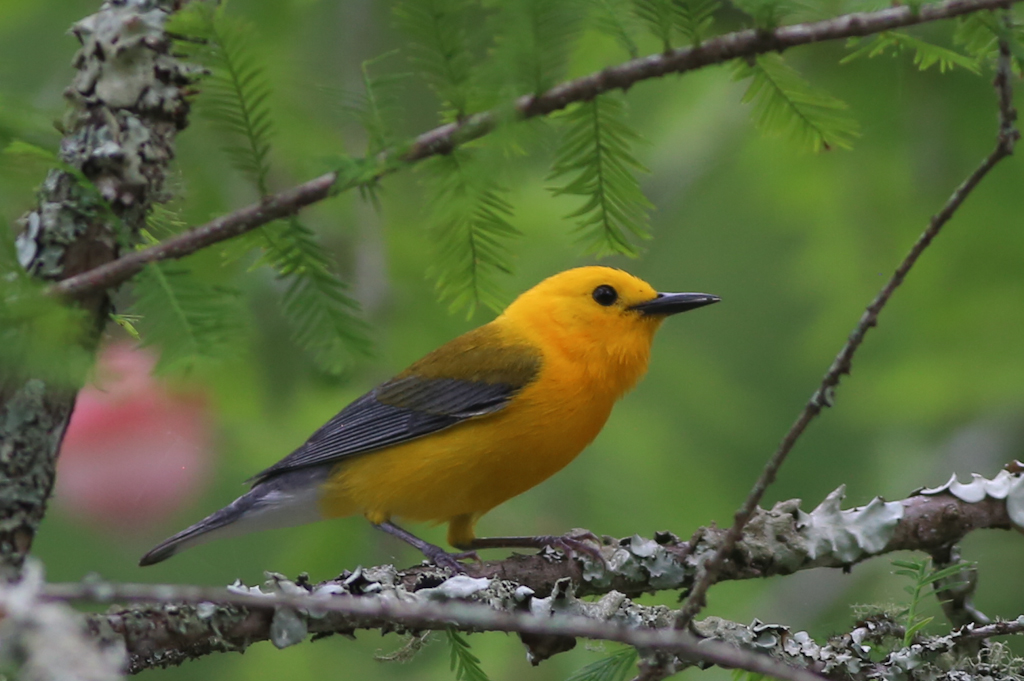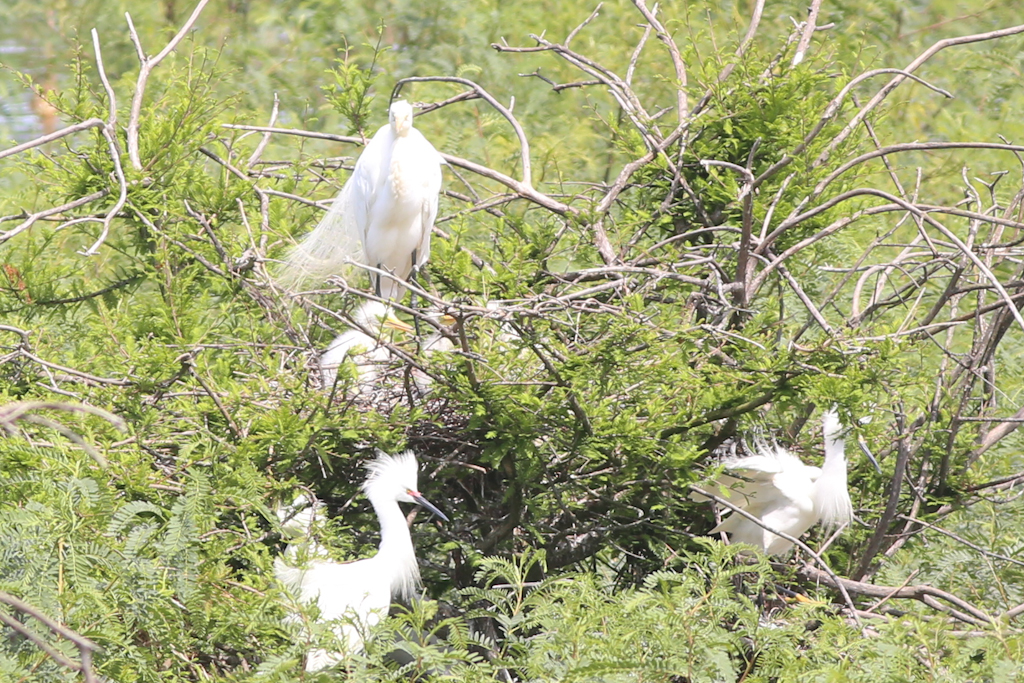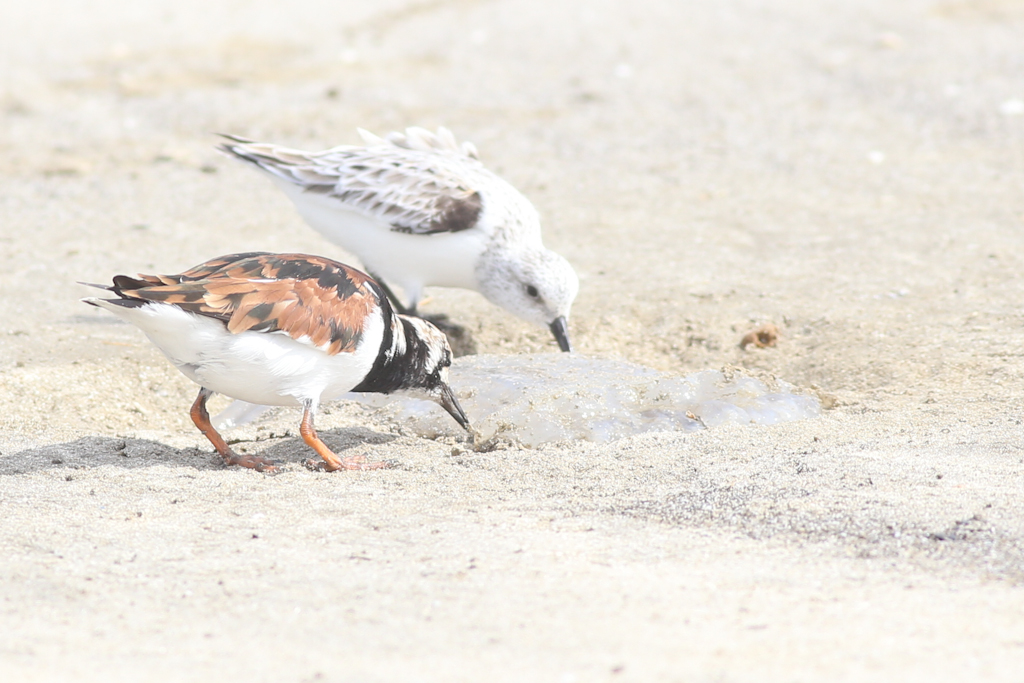WINGS Tour to Texas and Louisiana
18 - 25 April, 2024
The Gang: Brigid, Emily, Lynda, Rod, Susan, and Jon (bird guy)

There is always good, easy birding in eastern Texas. We started in the interior forests where we found Red-cockaded Woodpecker, Brown-headed Nuthatch, and Bachman’s Sparrows at the western limit of their ranges. Then we went to the coast. The fly-way is there, and the coastal forests can catch those birds migrating north from their wintering haunts in Central and South America… when the wind blows in the right direction. And, on a couple of our days, the wind was blowing just the way we wanted it to: from the north. The forests were alive with birds, a lot of warblers, including Kentucky, Golden-winged, Prothonotary, Cerulean, Bay-breasted, Blackpoll, and others adding up to a nice twenty-four species. We also had flocks of Indigo and Painted Buntings, lots of Scarlet and Summer Tanagers, and a steady stream of Yellow-billed Cuckoos. The grasslands had Upland Sandpipers, the marshes had Purple Gallinules, and everywhere was just plain, good birding fun.
To kick it off, our first day out we left Houston but didn’t leave Houston immediately. In the northern suburbs, surrounded by houses and highways, lies a woodlot in which we got the first of the major specialties of the region. We saw a pair of Red-cockaded Woodpeckers moving between their excavated holes in living pine trees – sap running down keeping ants and whatever away. We also had very accommodating Brown-headed Nuthatches, one posing in the scope for minutes. From there we continued north and east toward the piney woods with an emergency stop for a flock of Mississippi Kites over the highway, grabbing insects on the wing. We also enjoyed a Scissor-tailed Flycatcher on a power line over a busy intersection – we watched it while the light was red. Once we got into bigger woods we encountered some of the classic breeding birds. Northern Parulas were singing away and we had a scope view of one doing its thing. A bright male Summer Tanager worked some branches right over our heads while we had our picnic lunch. And, a spectacular Prothonotary Warbler appeared to be taking a break from its typical marshy thickets to poke around in some branches right in front of us. The breeding birds of east Texas were in good form and a nice start to the trip.





The day began in the recently burned (actually, still burning) piney woods of Angelina National Forest. This managed forest is the western range of Bachman’s Sparrow and we were treated to a long solo of a bird perched up on a bush. Meanwhile two male Indigo Buntings were singing and trying to distract us from this special bird. We were distracted. From this morning in the piney woods we undertook the drive to the coast almost taking out a Greater Roadrunner that blasted across the highway right in front of us. Fortunately, it was a good flyer, too, and made it safely to the other side. Mid-day we birded a wetland complex full of Purple Gallinules among Common Gallinules, White-faced Ibis, and American Alligators. Once on the coast we walked some wetlands and mudflats, though the highlights were less the shorebirds (though, the Wilson’s and Snowy Plovers were nice) and instead the Common Nighthawk asleep next to the parking lot and the bright Dickcissel perched atop a small tree. The drive to our base in Winnie was interrupted by just another alligator in the road.







In the middle of the night when the wind changed from south (from which it has been blowing for a week) to north, birders far and wide got goose bumps and knew that it was time for the coast. The southerly winds had been moving birds right over the gulf and up inland, but fighting those northerlies was going to make the coastal woodlands look like a very nice place to stop. That said, we started in High Island at dawn. There were pewees and Indigo Buntings around, many of each. Then we saw our first warbler a Worm-eating Warbler, then a Bay-breasted, and then, the tap was open and we saw more and more. There were thrushes and vireos and gaudy Painted Buntings and a Yellow-billed Cuckoo or two. We barely moved in about two hours. But, eventually, we tore ourselves away and took a quick break to check on some things on the Bolivar Peninsula. Shorebirds and terns were pretty good, and a lingering Chestnut-collared Longspur was even better, but for shear charisma the award went to a pair of Scissor-tailed Flycatchers hunting and having their streaming tails blown around in the wind. In the afternoon we went east to Sabine Pass and the woodlot there. There were easily hundreds of birders present, and for good reason, because the woods were hot with birds. The warbler list was formidable, but included some sweet birds like Golden-winged Warbler up high, Hooded Warbler down low, and Cerulean Warbler in the middle. We knew we had to have dinner sooner rather than later, but it was hard to pull away.




The next day we picked up where we left off, watching birds bubble in the trees at Sabine Woods. A lot of the same birds were still around, but a lot of new ones had arrived, or were in the process of arriving. That morning, but over the whole day, we saw dozens of Yellow-billed Cuckoos. Some were on the move, like all the ones we saw flying across the roads. Others were settling into the forest and resting. We saw them on the ground, in the trees, on fence wires, and even eating huge juicy caterpillars. Warblers were still starring the show, with abundant Blackpoll Warblers, generally a scarce migrant along the upper Texas coast. We also saw our first Blue-winged Warblers, and finally got good looks at Kentucky Warblers. After Sabine Woods, we returned to High Island and visited the Smith Oak Sanctuary and its spectacular heron rookery. The bubbling sounds of hundreds of nesting Snowy Egrets were bizarre and amazing. Great Egrets had gawky chicks and the Neotropic Cormorants chicks were just getting past their gawkiest. The Yellow-billed Cuckoo show continued here, too, but we were also treated to a very cooperative and generally rare Black-billed Cuckoo. Walking through the woods was to be with the thrushes, but an American Redstart hopping around in some low sticks fanning its fancy tail was a highlight. It was a busy birding day and was bountifully rewarded at its end by a mountain of Cajun food.


South winds all night blew the migrants out of the coastal woodlands, so our foray to the cheniers of Louisiana weren’t as productive as the previous two days, but there were still birds to look at. We got some looks at a Chuck-wills-widow when one flushed, and a Painted Bunting was singing from a treetop. At lunch we found our first Philadelphia Vireo of the trip, something of a surprise given how few birds were around today relative to yesterday. The big haul of birds today, though, was out on the Bolivar Peninsula. We started with Seaside Sparrows in the salt grass, watching them sing from the marsh. We then moved out onto the legendary Bolivar Flats that held thousands of shorebirds and terns. Reddish Egrets were dancing around madly in the shallows. Piping Plovers were poking around in the wrack. A Yellow-crowned Night-Heron nailed a frog while its blond plume blew in the breeze. Meanwhile over a thousand American Avocets waded off the flats and hundreds of Black, Least, Royal, Common, and Forster’s Terns rested on the sand or foraged along the shore. It was system overload and a great end to the day.









Wrapping up the trip is a slow event, that starts with birding, continues with birding, and works a drive into Houston in there somewhere. We began with Anahuac National Wildlife Refuge, actually the road to the refuge where we were treated to lots of Upland Sandpipers, lots of singing Dickcissels, and a pair of Northern Bobwhite right along the road. When we finally got to Anahuac, among other things, we drove the famous loop road through the marsh. It was bubbling with birds and the air was full of the roars of displaying American Alligators. Shorebirds were showing well with plenty of birds in their breeding plumage including dozens of Stilt Sandpipers. At one point, a Least Bittern flew right in front of the van, landed in some reeds, and sat in the open for several minutes while we watched. After that we made a lot of farm field drives and short little stops to check interesting whatnots and see the spider lilies. A tree full of Crested Caracaras was pretty cool. There were Scissor-tailed Flycatchers here and there along the road, and our last stop had more Upland Sandpipers. Our final push was through traffic back into Houston for a final dinner and the recap of fun stories from road.
